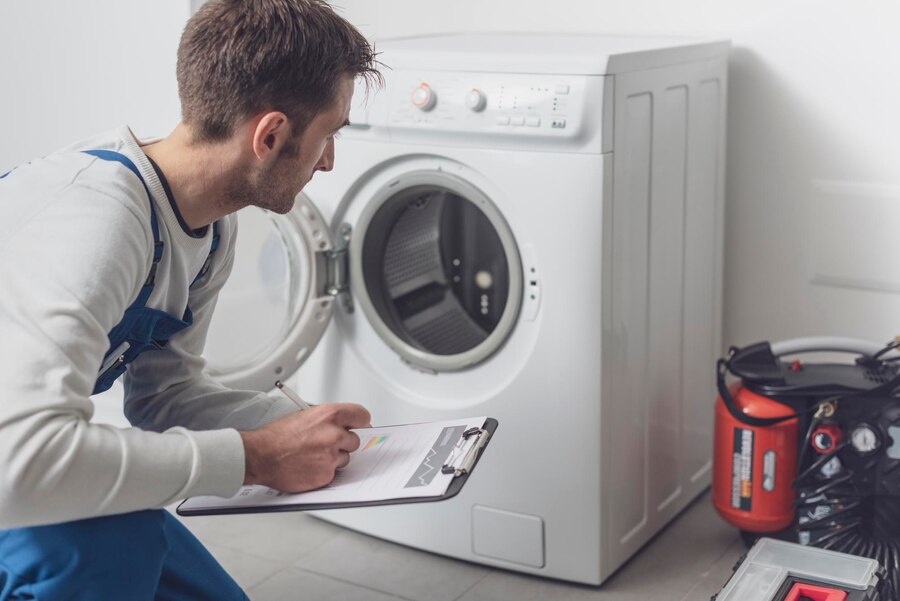Call for Emergency
+1(778)-234-0760
You will need an appliance repair service that has the ability to repair different types of dryers, for home or business use – this service is for you. At EDELLIN Home Services, we offer dryer repair Vancouver solutions tailored to your needs. Our skilled dryer repair technicians have extensive experience working with all kinds of dryers. Whether you require a dryer repair service Vancouver for a household dryer or a commercial unit, rest assured that our expertise ensures we can efficiently address your dryer repair needs promptly and effectively.
Questions
DRYER IS NOT HEATING
If your dryer is operational but fails to generate heat, you're encountering one of the most prevalent issues in dryer repairs. Typically, this problem can be traced back to a blown fuse or a malfunctioning heating element. In certain instances, resolving this heat-related problem may necessitate the replacement of the main control board.
- ● Thermal Fuse: The thermal fuse serves as a safeguard against dryer overheating. Fuses are commonly positioned on the blower housing near the heat source of the dryer. In electric dryers, this is typically the heating element, while in gas dryers, it's located at the burner. When the fuse blows, it will exhibit no continuity, as indicated by a multimeter
- ● Heating Element Assembly: Responsible for warming the air within your dryer and circulating it into the drum, the heating element assembly may wear out over time. It can be examined for continuity using a multimeter, and if necessary, repaired or replaced.
PIPE CONNECTION
When your dryer seems to be taking an eternity to complete its drying cycle, the culprit often lies in airflow issues. If the exhaust vent is obstructed or the blower wheel is faulty, the dryer struggles to draw in sufficient air, resulting in extended drying times. Regularly cleaning the vent, at least annually, is crucial in preventing these issues. In some cases, a simple obstruction, like a stray sock in the blower wheel, could be causing the delay.
- ● Air Flow Obstruction: A clogged exhaust vent significantly hampers your dryer's efficiency, leaving excess moisture in the machine. Manually inspect your dryer's vents to ensure smooth airflow.
- ● Lint Filter: A full or clogged lint filter can impede airflow. Regular manual cleaning of the lint filter is recommended.
- ● Blower Wheel: Attached to the drive motor, the blower wheel propels air into the dryer drum. It may get blocked by lint and other debris. Check the blower wheel's condition by removing the vents and assessing the airflow's strength. A well-functioning blower wheel should not wobble when turned by hand.
- ● Gas Valve Solenoid: If the gas valve solenoids fail after the dryer has started, it leads to prolonged drying times. Test the solenoids by observing the igniter – if it glows but doesn't ignite the gas, the solenoid is likely defective.
- ● Heating Elements: Responsible for heating the air, the heating element may burn out over time. Test it using a multimeter; if there's no continuity, replacement is necessary. Regular maintenance is crucial for optimal drying performance.
ISSUES WITH STARTING THE DRYER
When your dryer refuses to kick into action, various factors may be at play, preventing a smooth start.
- ● Blown Thermal Fuse: Acting as a safety measure against overheating, a blown thermal fuse could be the reason behind your non-starting dryer. Located on the blower housing or near the heat source, the fuse's continuity can be checked with a multimeter. A useful tip: a blown thermal fuse might signify a clogged exhaust vent, so inspect it for any blockages.
- ● Faulty Start Switch: The start switch, if defective, can impede the dryer's functionality. To test this, attempt to start the dryer. If it emits a humming sound but doesn't start, the start switch is likely intact. Conversely, if there's complete silence, the start switch may be the culprit. Confirm its condition using a multimeter.
- ● Door Switch: Responsible for engaging when the dryer door is closed, the door switch should audibly "click." Test its functionality using a multimeter.
- ● Drive Belt and Belt Switch: On certain models, a broken drive belt might allow the motor to run, but a belt switch would shut down the system in the presence of a broken belt. Determine if your model incorporates a belt switch.
- ● Circuits, Outlets, and Plugs: Rule out electrical issues by plugging another device into the outlet. Inspect your circuit breaker for blown fuses, and scrutinize the dryer plug for signs of damage.
- ● Addressing these factors systematically can help pinpoint the cause of your dryer's reluctance to start.
NOISE ISSUES WITH THE DRYER
If your dryer has suddenly become a source of unwelcome noise, the likely culprits are a broken belt, a malfunctioning drum roller, or a worn drum roller axle.
- ● Drive Belt: This elongated belt, wrapping around the entire dryer drum, tension pulley, and drive motor, is subjected to significant strain and may break or fray over time. If signs of wear are evident, it's essential to replace the drive belt promptly.
- ● Drum Rollers: A thorough inspection of the drum rollers is necessary. Depending on the dryer model, there might be one or several drum rollers. It's often advisable to replace all drum rollers if any one of them shows signs of wear.
- ● Drum Roller Axle: Many dryers feature two or more drum support rollers at the front and back of the drum. Testing these rollers involves removing the drive belt and manually turning the drum. If the drum spins evenly and freely, the drum roller axles are in good condition.


